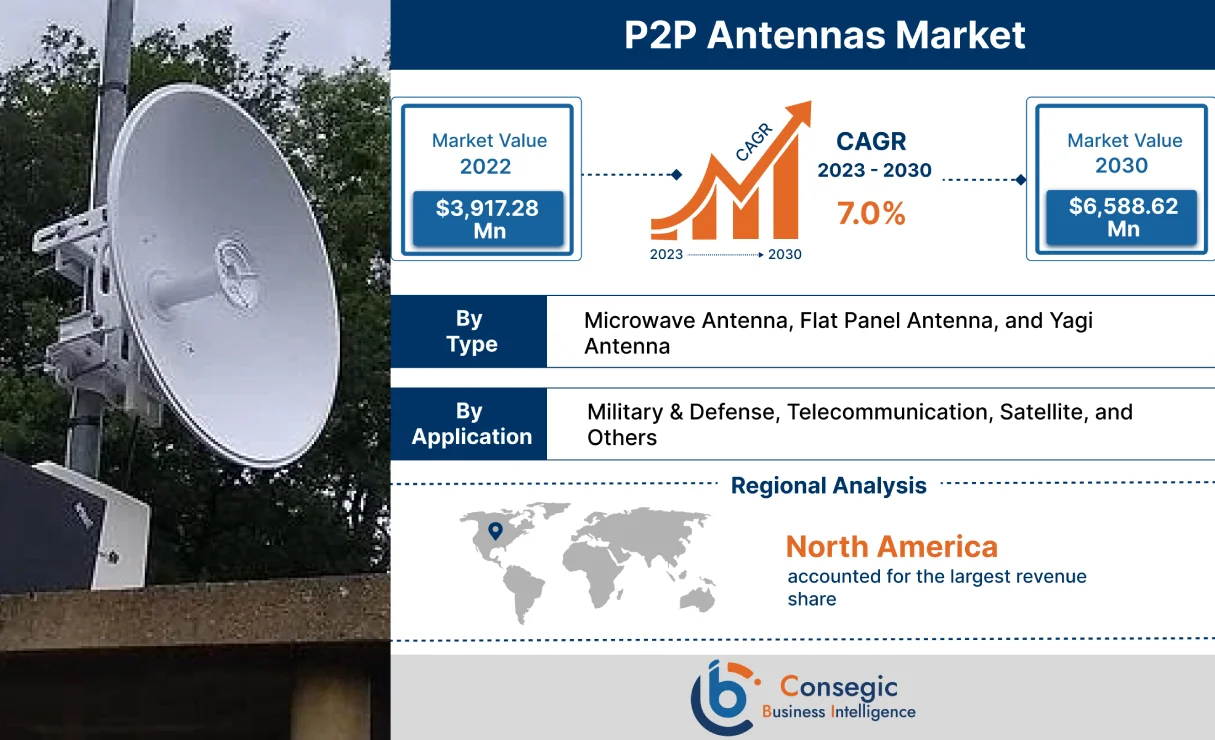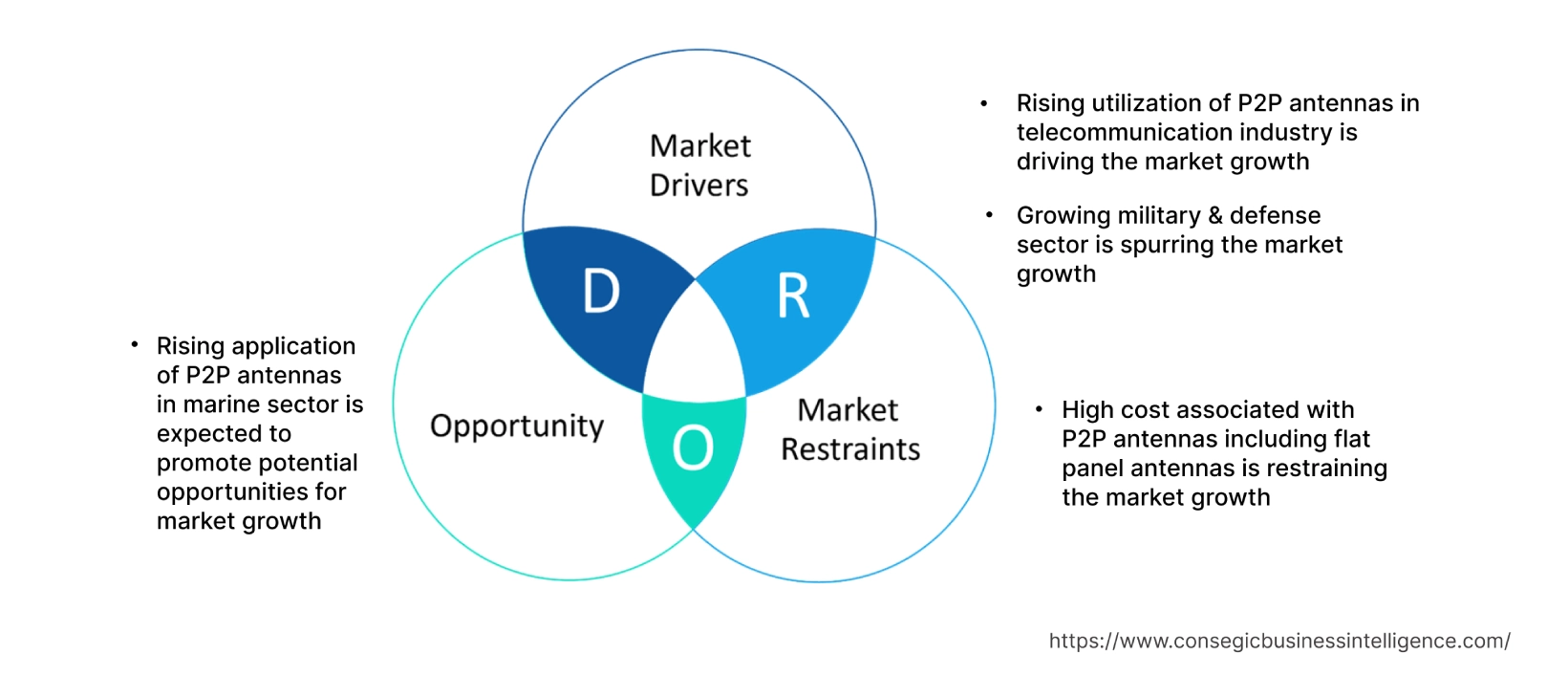- Summary
- Table Of Content
- Methodology
P2P Antennas Market Size :
P2P Antennas Market size is estimated to reach over USD 6,588.62 Million by 2030 from a value of USD 3,917.28 Million in 2022, growing at a CAGR of 7.0% from 2023 to 2030.
P2P Antennas Market Scope & Overview:
P2P (point to point) antennas are designed for utilization between two endpoints to support bidirectional traffic flow and communication connection between two nodes or endpoints. Moreover, P2P antennas offer a range of benefits including reliable connectivity, high speed, less delay, ease of installation, electronic steering for low maintenance, and others. The aforementioned benefits of P2P antennas are primary determinants for increasing its deployment in military & defense, telecommunication, satellite, and other related applications.
P2P Antennas Market Insights :
Key Drivers :
Rising utilization of P2P antennas in telecommunication industry is driving the market growth
P2P antennas are primarily used in the telecommunication sector for various applications including base stations, broadcast stations, and communication systems among others. P2P antennas are utilized in telecom network deployments that require central device such as a base station antenna to broadcast signals to more than one receiving antennas. Additionally, P2P antennas offer several benefits including high directivity, electronic steering capabilities, and increased coverage area, which are primary aspects for driving its utilization in telecommunication sector.
Factors including the increasing demand for wireless communication, growing deployments of 5G infrastructure, and rising adoption of smartphones and advanced communication devices are among the vital prospects driving the growth of the telecommunication industry.
For instance, according to the Ookla 5G Map, the overall 5G deployments reached up to 112 countries in November 2021, depicting an increase of 13% in contrast to 99 countries in November 2020. Additionally, Ookla further states that the total number of 5G deployments increased significantly and reached up to 85,602 deployments in 2021 as compared to 17,428 deployments in 2020.
Hence, the growing telecommunication industry is increasing the adoption of P2P antennas for its application in telecom base stations and communication systems for providing reliable signal and connectivity solutions, in turn driving the growth of the market.
Growing military & defense sector is spurring the market growth
P2P antennas are primarily used in the military & defense sector for applications involving military vehicles, defense aircraft, and radar among others. P2P antennas are low-profile, lightweight antennas that offer high reliability, robust design, and low power consumption, which makes them ideal for delivering superior communication capabilities in the harshest environments. Additionally, P2P antennas offer reliable and efficient connectivity at multiple frequency bands and have the ability to withstand extreme weather conditions and offer seamless connectivity for critical operations. The aforementioned features of P2P antennas are increasing its adoption in the military & defense sector.
Factors including the increasing investments in military & defense equipment and vehicles along with rising production of air defense systems are primary determinants for driving the growth of the military & defense sector.
For instance, in December 2022, Dassault Aviation, a France-based manufacturer of military aircraft and business jets, launched its new Rafale fighter aircraft for its application in the French military procurement agency called the Directorate General of Armaments. Further, in December 2022, the Department of Defence of the United States invested around USD 50 million for the automation of future army ground vehicles that is led by the Army's Robotic Combat Vehicle program. The investment aims at supporting the military vehicles designed for surveillance, reconnaissance, and high-risk missions.
Therefore, the rising investments in the military & defense sector and increasing production of military aircraft are driving the adoption of P2P antennas for delivering superior communication capabilities among military & defense vehicles. The above factors are further proliferating the growth of the market.
Key Restraints :
High cost associated with P2P antennas including flat panel antennas is restraining the market growth
The deployment of P2P antennas such as flat panel antennas is often associated with high cost, which is a key factor constraining the market growth.
For instance, in June 2020, ALCAN Systems, manufacturer of flat panel antennas, launched its new electronically steered flat panel antenna that is primarily designed for Medium Earth Orbit (MEO), and Low Earth Orbit (LEO) satellite constellations operating on Ka-band frequency at a price of approximately USD 1,687 per unit, which is relatively higher in comparison to conventional antennas.
Therefore, high cost associated with the utilization of P2P antennas involving flat panel antennas is restraining the growth of the market.
Future Opportunities :
Rising application of P2P antennas in marine sector is expected to promote potential opportunities for market growth
The rising application of P2P antennas in marine sector is expected to present potential opportunities for the growth of the P2P antennas market. P2P antennas are often utilized in the marine industry for applications including commercial ships, yachts, offshore support vessels, and passenger ships to facilitate maritime satellite communications. P2P antennas provide compact and robust design, easy-to-install footprint, along with high resistance against damage from vibration, shock, dust, rain, and humidity. The aforementioned characteristics of P2P antennas are prime factors increasing its application in the marine industry.
Factors including the increasing investments in the marine sector and new shipbuilding projects are expected to promote lucrative growth aspects for the market.
For instance, in May 2022, Damen Shipyards Group delivered the first of three multi-mission inshore marine vessels to the South African Navy while the remaining two vessels are scheduled for delivery in June 2023 and September 2024 respectively. Additionally, in February 2021, A.P. Moller – Maersk announced the launch of its new carbon-neutral liner vessel in Denmark. The new vessel is scheduled for delivery in 2023.
Hence, the increasing production from the marine industry is anticipated to increase the adoption of P2P antennas for providing maritime satellite communications in several applications including commercial ships, cruise ships, and off-shore vessels among others, in turn fostering opportunities for market growth during the forecast period.
P2P Antennas Market Report Insights :
| Report Attributes | Report Details |
| Study Timeline | 2017-2030 |
| Market Size in 2030 | USD 6,588.62 Million |
| CAGR (2023-2030) | 7.0% |
| By Type | Microwave Antenna, Flat Panel Antenna, and Yagi Antenna |
| By Application | Military & Defense, Telecommunication, Satellite, and Others |
| By Region | North America, Europe, Asia-Pacific, Latin America, and Middle East & Africa |
| Key Players | COMMSCOPE, RadioWaves Inc., Guangdong Shenglu Telecommunication Tech. Co. Ltd., Telefonaktiebolaget LM Ericsson, mWAVE Industries LLC, Kavveri Telecoms, Gilat Satellite Networks, Comba Telecom Systems Holdings Ltd., Amphenol Corporation, Laird Connectivity, ALCAN Systems GmbH |
P2P Antennas Market Segmental Analysis :
By Type :
Based on the type, the market is bifurcated into microwave antenna, flat panel antenna, and yagi antenna. The microwave antenna segment accounted for the largest revenue share of 38.46% in the year 2022. Microwave antennas are designed to obtain and transfer electromagnetic radiation with wavelengths between infrared radiation and radio waves. Microwave antennas are utilized for broadcasting microwave transmissions between two or more locations along with deployment radar, electronic warfare, and other related applications. Moreover, microwave antennas offer several benefits including higher efficiency, efficient data transmission at high frequencies, compact size, and high directivity among others. The aforementioned benefits of microwave antennas are key aspects for driving its adoption in telecommunication, military & defense, and other related applications.
According to Viavi Solutions Inc., the overall number of cities across the world with 5G deployments reached 1,947 as of January 2022, along with the addition of 635 new 5G cities in 2021. Hence, the growth of telecommunication sector is among the key factors driving the deployment of microwave antennas for utilization in telecommunication base stations and communication systems, in turn contributing to the growth of the market.
The flat panel antenna segment is anticipated to register fastest CAGR growth during the forecast period. Flat panel antennas offer multi-orbit capabilities and operate at more than one pointing angle at a time. Flat panel antennas are capable of radiating multiple beams simultaneously to direct radio waves on a static antenna. Moreover, flat panel antennas offer various features including reliable connectivity, low profile installation options, electronic steering for low maintenance, simple power-on start-up, and auto-acquisition for easy operation. The aforementioned features of flat panel antennas are the key determinants increasing its application in military & defense, telecommunication, and satellite communications among others.
For instance, in June 2023, Kymeta Corporation launched its first flat panel antenna that is specifically designed for application in marine industry to offer superior performance and reliable connectivity at sea. Hence, the rising innovations associated with flat panel antennas are anticipated to drive the market growth during the forecast period.
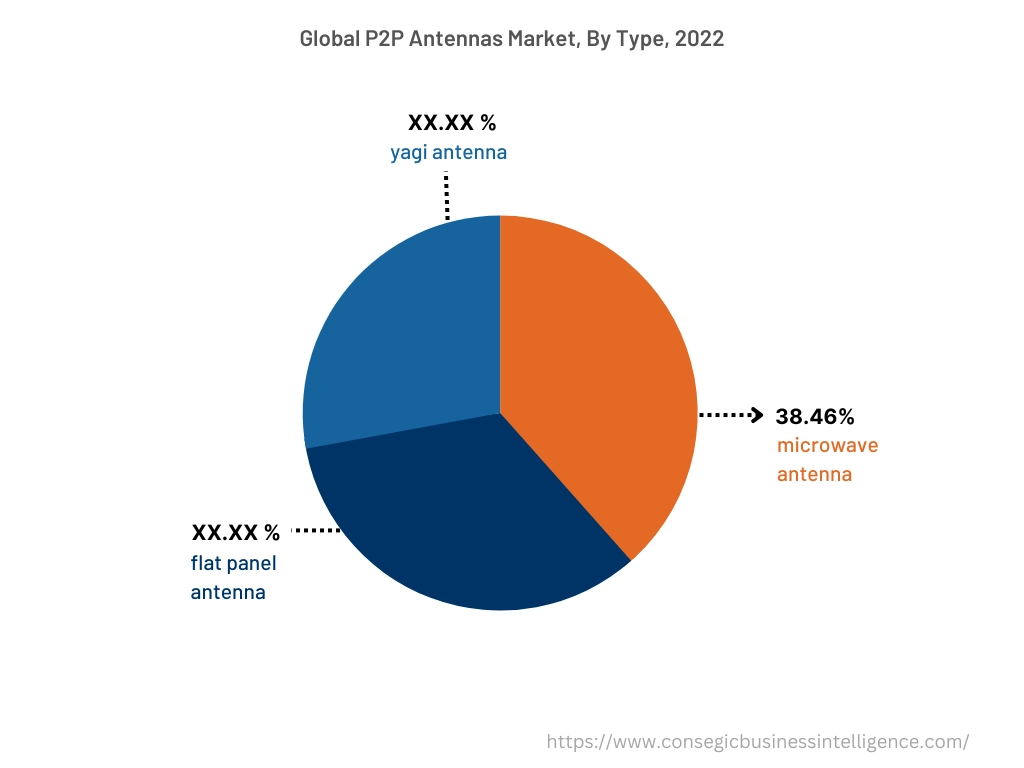
By Application :
Based on the application, the market is segregated into military & defense, telecommunication, satellite, and others. The telecommunication segment accounted for the largest revenue share in the year 2022. Factors including the increasing demand for wireless communication, growing penetration of 5G infrastructure, and rising need for high-speed data and internet services are driving the growth of the telecommunication sector.
For instance, according to GSM Association, most of the countries in European region deployed commercial 5G services in 2021, while approximately two thirds of regional operators launched 5G networks. GSM Association further states that 5G connections across the European region are projected to reach 311 million by the end of 2025. Therefore, the growth of telecommunication sector is driving the adoption of P2P antennas for utilization in base stations and broadcast stations among others, in turn proliferating the growth of the market.
Military & defense segment is expected to witness fastest CAGR growth during the forecast period. The growth of military & defense segment is attributed to several factors including increasing investments in military & defense vehicles along with rising production of air and maritime defense systems are key determinants for driving the growth of the military & defense segment.
For instance, in April 2022, Huntington Ingalls Industries introduced its new Block IV Virginia-class attack submarine that is primarily developed for the U.S. navy. The submarine is optimized to perform various coastal and open-water missions. The submarine is equipped with the latest technologies and offers improved maneuverability, stealth, and firepower capabilities. Thus, the rising development of military & defense systems is driving the adoption of P2P antennas for delivering superior communication capabilities and connectivity solutions for critical operations, in turn proliferating the market growth during the forecast period.
By Region :
The regional segment includes North America, Europe, Asia Pacific, Middle East and Africa, and Latin America.
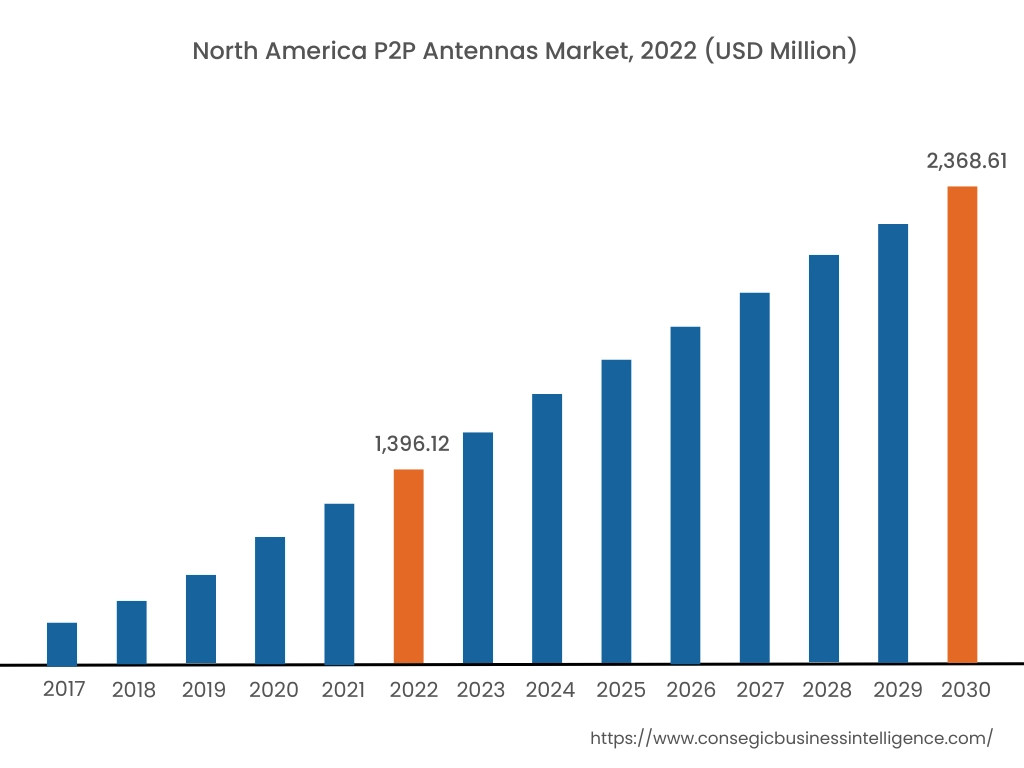
North America accounted for the largest revenue share of USD 1,396.12 Million in 2022 and is expected to reach USD 2,368.61 Million by 2030, registering a CAGR of 7.1% during the forecast period. In addition, in the region, the U.S. accounted for the maximum revenue share of 55.34% in the same year. The adoption of P2P antennas in the North American region is primarily driven by its usage in military & defense, telecommunication, and other sectors. Additionally, the rising utilization of P2P antennas in networking and telecommunication infrastructure including base station and broadcast stations are among the significant factors driving the market growth in the region. For instance, according to the GSM Association, the deployment of 5G connections across North America reached approximately 140 million as of 2022. Hence, the growing telecommunication industry is boosting the deployment of P2P antenna for high speed communication and data transfer applications, in turn driving market growth in the North American region.
Furthermore, factors including the increasing investments in military & defense and satellite communication systems are anticipated to foster opportunities for market growth in North America during the forecast period.
Asia-Pacific is expected to register fastest CAGR growth of 7.3% during the forecast period. The growing pace of industrialization and development is creating lucrative growth prospects for the market in the region. Additionally, factors including the growth of multiple industries such as military & defense, telecommunication, and others are driving the market growth for P2P antennas in the Asia-Pacific region.
For instance, according to Invest India, the Government of India allocated USD 70.6 billion to the Ministry of Defense as the part of its Union Budget 2022-23. The primary focus of the budget allocation to the Indian Ministry of Defense is to help in the development of new unmanned vehicles and systems, military ground vehicles, and other related systems. Hence, rising investment in military & defense sector is anticipated to drive the utilization of P2P antennas for providing superior communication and connectivity capabilities among defense systems, thereby, driving market growth in the Asia-Pacific region during the forecast period.
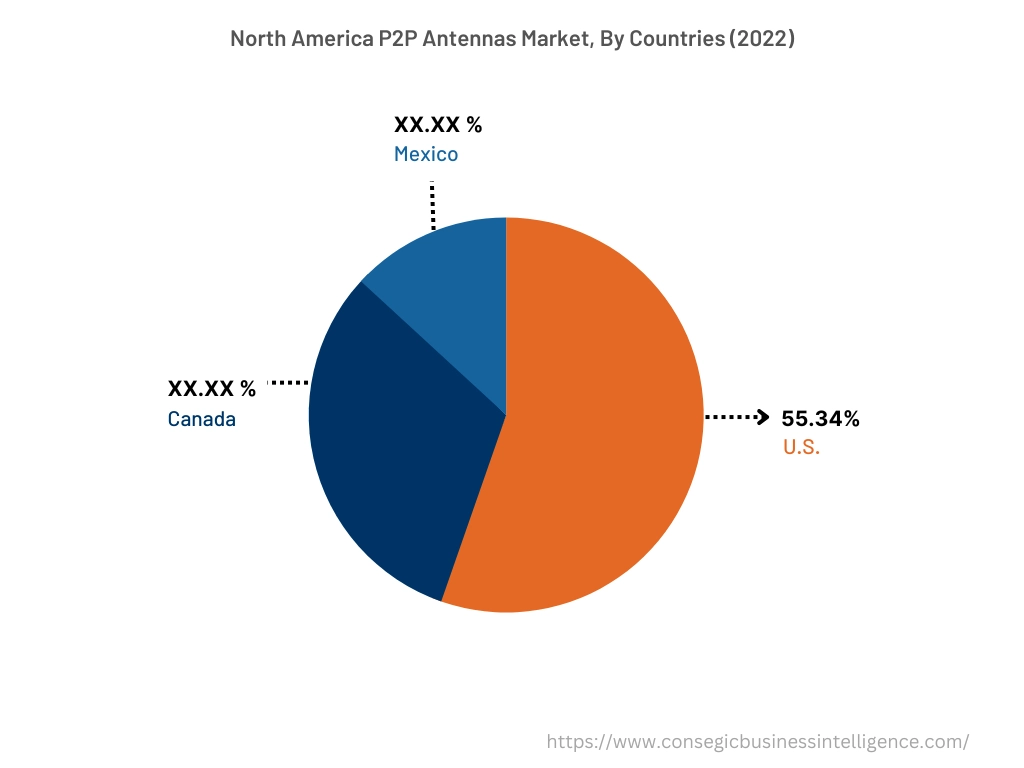
Top Key Players & Market Share Insights:
The P2P antennas market is highly competitive with major players providing P2P antennas to the national and international markets. Key players are adopting several strategies in research and development (R&D), product innovation, and application launches to hold a strong position in P2P antennas market. Key players in the P2P antennas market include-
- COMMSCOPE
- RadioWaves Inc.
- Amphenol Corporation
- Laird Connectivity
- ALCAN Systems GmbH
- Guangdong Shenglu Telecommunication Tech. Co. Ltd.
- Telefonaktiebolaget LM Ericsson
- mWAVE Industries LLC
- Kavveri Telecoms
- Gilat Satellite Networks
- Comba Telecom Systems Holdings Ltd.
Recent Industry Developments :
- In March 2023, RadioWaves Inc. launched a new line-up of P2P (point-to-point) antennas. The P2P antenna portfolio comprise of parabolic antennas with frequency ranging from 4.9 GHz to 7.125 GHz.
Key Questions Answered in the Report
What is P2P antennas? +
P2P (point to point) antennas are designed for utilization between two endpoints to support bidirectional traffic flow and communication connection between two nodes or endpoints.
What specific segmentation details are covered in the P2P antennas report, and how is the dominating segment impacting the market growth? +
For instance, by type segment has witnessed microwave antenna as the dominating segment in the year 2022, owing to its increasing utilization in telecommunication, military & defence, and other related applications.
What specific segmentation details are covered in the P2P antennas market report, and how is the fastest segment anticipated to impact the market growth? +
For instance, by application segment has witnessed military & defence as the fastest-growing segment during the forecast period due to the rising adoption of P2P antennas for delivering superior communication capabilities and connectivity solutions for critical military operations.
Which region/country is anticipated to witness the highest CAGR during the forecast period, 2023-2030? +
Asia-Pacific is anticipated to register fastest CAGR growth of 7.3% during the forecast period due to rapid pace of industrialization and growth of multiple industries such as military & defence, telecommunication, and others.
